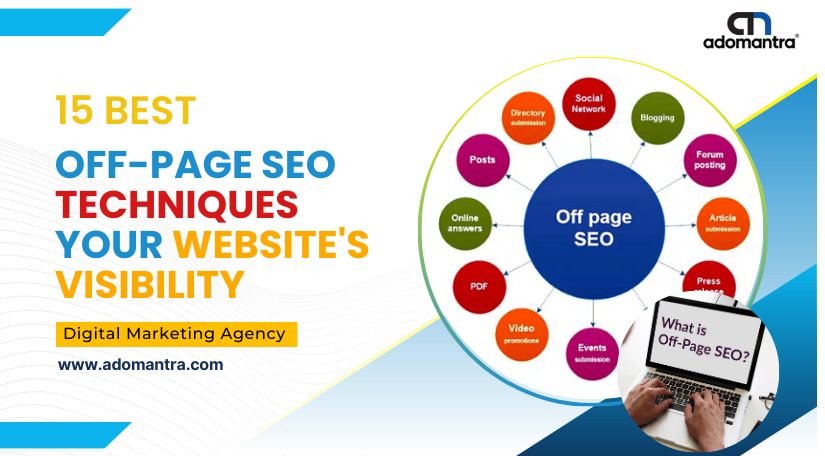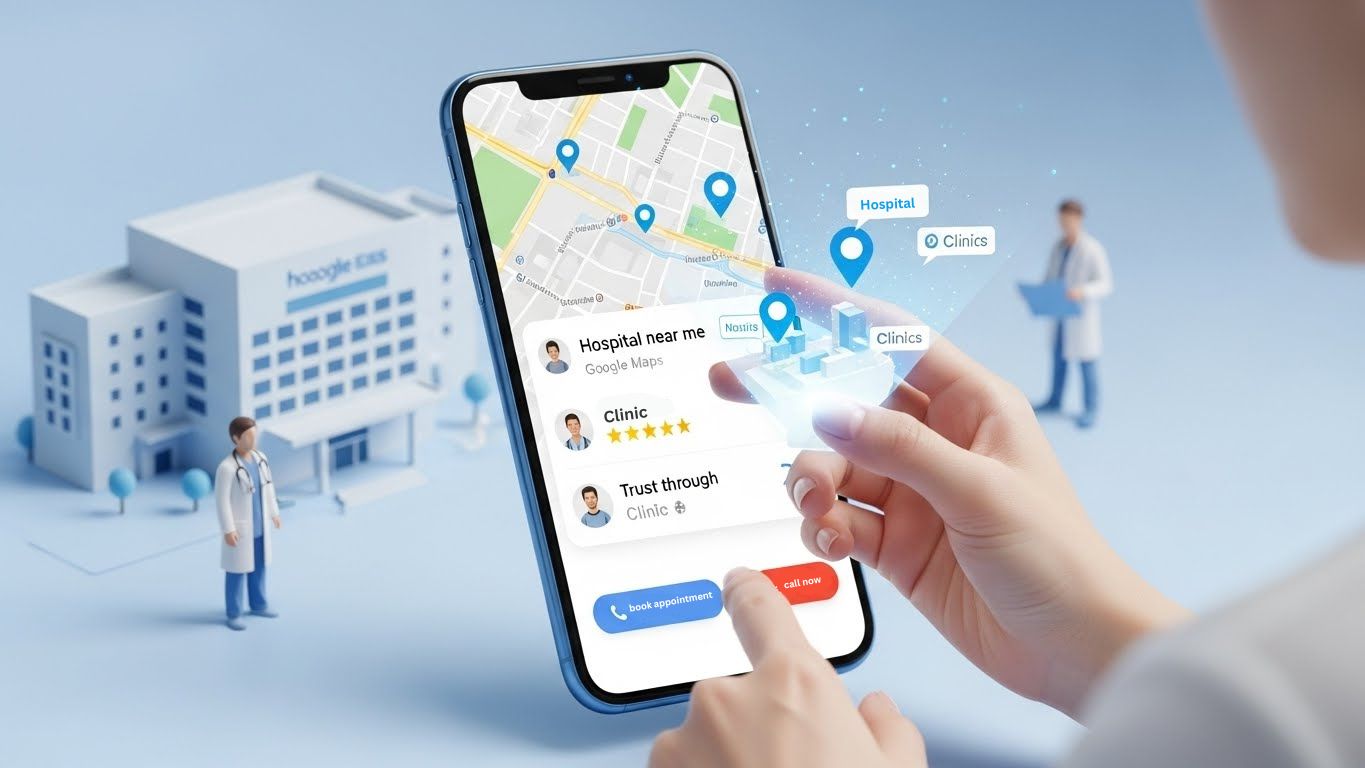
15 Must Know Off-page Seo Techniques Your Website's Visibility
Welcome to the definitive guide on "15 Must-Know Off-Page SEO Techniques to Boost Your Website's Visibility." If you're reading this, chances are you already understand the power of SEO in driving organic traffic to your website. You've probably optimized your on-page elements—like headers, meta descriptions, and content—to meet the best practices of search engines. off page seo strategies However, did you know that the work you do off your website is just as important as what you do on it?
That's right, Off-Page SEO is a crucial part of your overall SEO strategy and can significantly impact your site's visibility in search engine rankings. Simply put, while on-page SEO makes your site understandable to search engines, off-page SEO tells search engines how the world perceives your website. off page seo strategies A well-rounded SEO strategy includes both elements working in harmony, and this guide focuses on the Off-Page SEO techniques you absolutely must know to improve your site's credibility, reach, and, ultimately, its visibility.
What is SEO?
SEO, or Search Engine Optimization, is the process of optimizing a website or online content to improve its visibility in search engine results pages (SERPs). The goal is to attract more organic (non-paid) traffic to the site. Higher visibility in the search results means more users can find and access the website, leading to increased engagement and potential business opportunities.
There are three primary components of SEO:
- On-Page SEO
- Technical SEO
- Off-Page SEO
What is Technical SEO?
Technical SEO refers to the practice of optimizing the technical aspects of a website to improve its ranking in search engine results. Unlike On-Page SEO, which focuses on content and user experience, Technical SEO concentrates on enhancing the website's underlying framework and architecture. The objective is to improve search engines' ability to crawl, index, and understand a website, thereby enhancing its visibility and making it easier for users to find and interact with the site.
What is On-Page SEO?
On-Page SEO refers to the practice of optimizing individual web pages on a site to rank higher and earn more relevant traffic from search engines. Unlike Off-Page SEO, which involves external signals and links, On-Page SEO focuses on aspects that are within the website owner's control. Essentially, it's all about making sure that your website is user-friendly and search-engine-friendly, so both search engines and users can find it easily.
What is Off-Page SEO?
Off-Page SEO refers to all the activities that you and others do away from your website to raise the ranking of a page with search engines. Unlike On-Page and Technical SEO, which focus on optimizing your website and its content, Off-Page SEO focuses on increasing the authority of your domain through content creation and earning backlinks from other websites. off page seo strategies The primary goal is to create a strong, lasting impression of your site in the eyes of search engines and audiences alike, thereby improving your site's credibility, trustworthiness, and ultimately, its search ranking.
Why is off-page optimization important?
Off-page optimization is crucial because it serves as a measure of your website's credibility, relevance, and authority in the eyes of search engines and users alike. While on-page SEO focuses on content quality and structure, off-page SEO validates that content by building a network of high-quality backlinks, social signals, and other external factors. These collectively help search engines understand how the world perceives your website, thereby influencing your ranking in search engine results pages (SERPs). An effective off-page SEO strategy not only boosts your visibility but also fosters trust and establishes your website as an authoritative source in your industry. The end result is increased organic traffic, better conversion rates, and a more significant online presence.
Top 15 Off Page Seo Technique To Your Website Visibility
- Link Building
- Guest Posting
- Business Listing
- Forum Posting
- Local Seo
- Press Releases
- Profile Creation
- Question Answer
- Article Submission
- Pdf Submission
- Blog Submission
- Social Bookmarking
- Web 2.0 Submission
- Image Submission
- Infographic Submission
Link Building
Link building is one of the most important and effective Off-Page SEO techniques. It involves the process of acquiring hyperlinks from other websites that point back to your own site. These links, commonly known as backlinks or inbound links, act as votes of confidence from one site to another. The quality and quantity of these links play a significant role in determining how well a page ranks in search engine results.
Why is Link Building Important?
- Search Engine Rankings: Backlinks are among the top factors that search engines consider for ranking a website. High-quality backlinks signal to search engines that your site is reputable and trustworthy.
- Web Traffic: Quality links from high-traffic websites can direct users to your site, increasing your organic reach.
- Authority and Credibility: Earning links from authoritative websites in your industry can establish your site as an authority in the field.
- Networking: The link-building process often involves outreach and collaboration, helping you build valuable relationships in your industry.
- Competitive Edge: Effective link building can give you an edge over competitors who have fewer high-quality links.
Types of Backlinks
- Editorial Links: These are natural links that other website owners give to your content because they find it valuable or relevant.
- Guest Post Links: These come from articles you write and publish on third-party websites, ideally in the same industry or a related field.
- Social Media Links: While not as impactful as other types of links, social media can still provide backlinks and direct traffic to your site.
- Web Directories and Citations: Listing your website in reputable online directories can provide backlinks, although these are generally less valuable than other types of links.
Best Practices for Link Building
- Quality Over Quantity: Focus on earning high-quality backlinks from reputable websites rather than accumulating a large number of low-quality links.
- Relevancy: Aim for links from websites that are relevant to your industry or topic.
- Diverse Link Profile: A varied mix of backlinks is generally viewed more favorably by search engines than many links coming from a single source.
- Anchor Text: Use descriptive, relevant anchor text for your links, but avoid over-optimizing with exact-match keywords.
- Avoid Black Hat Techniques: Steer clear of unethical practices like link farms, buying links, or using spammy content, as these can result in penalties.
- Monitor and Analyze: Regularly check the quality of your backlinks and their impact on your SEO performance.
Guest Posting
Guest Posting, also known as guest blogging, is a content marketing and SEO strategy where you write and publish an article on a website other than your own. This technique is a win-win for both the host website and the guest contributor. The host site gets free, quality content that provides value to its audience, while the guest poster receives exposure and the opportunity to build backlinks, which are valuable for SEO.
Why is Guest Posting Important?
- Backlinks: One of the primary benefits of guest posting is the opportunity to earn high-quality backlinks, which can improve your website's search engine rankings.
- Authority and Credibility: Publishing content on reputable sites establishes you as an expert in your field.
- Exposure and Traffic: Guest posting on popular websites puts your content in front of a new, larger audience, increasing the chances of driving more traffic to your own site.
- Networking: It offers an excellent opportunity to connect with other influencers and professionals in your industry.
- Brand Awareness: By contributing valuable insights on other platforms, you can increase awareness and recognition of your brand.
How to Approach Guest Posting
- Research: Identify reputable websites in your niche or industry that accept guest posts. Make sure these sites have a sizable and engaged audience.
- Pitch: Once you've identified potential host websites, craft a compelling pitch that outlines the value your guest post would bring.
- Quality Content: Write high-quality, unique content that fits the style and expectations of the host website while offering valuable information to its audience.
- Optimize: Make sure to optimize the content for SEO, but don't overstuff it with keywords. Also, use proper formatting, headings, and bullet points for readability.
- Backlinks: Typically, you'll have the opportunity to include a link back to your own site either within the content or in an author bio. Make sure this link adds value to the content and isn't just self-promotional.
- Follow Up: After the post is published, engage with readers by responding to comments and questions. Also, share the post on your social media channels.
- Monitor: Track metrics like traffic, backlink quality, and any increase in followers or engagement to measure the effectiveness of your guest posting efforts.
Best Practices
- Target the Right Sites: Choose websites that are reputable and relevant to your industry.
- Follow Guidelines: Many websites have guest post guidelines. Make sure to read and follow these meticulously.
- Add Value: Your content should provide genuine value to the host site's audience, not just serve as a platform for self-promotion.
- No Duplicate Content: Always submit original content and avoid duplicating articles you've already published elsewhere.
- Professional Tone and Style: Maintain a professional tone that aligns with your brand and the host website.
- Disclosure: If you're getting compensated for the guest post, it’s best practice to disclose this information.
Business Listing
Business Listing is a public profile that contains a business’s vital information such as name, address, phone number, website, hours of operation, and more. These profiles can appear on various online platforms like Google My Business, Yelp, Yellow Pages, and industry-specific directories. A business listing serves as an additional avenue for potential customers to find a company and is considered a fundamental aspect of local SEO.
Why are Business Listings Important?
- Visibility: Having your business listed on multiple platforms increases your online visibility, which can lead to higher traffic both online and offline.
- Local SEO: Accurate business listings contribute to your local search engine rankings, making it easier for customers to find you when they search for services in your area.
- Credibility: Listings on reputable platforms can enhance your business’s credibility and reputation.
- Customer Engagement: These platforms often allow for customer reviews and ratings, which can serve as valuable social proof and help you understand customer needs.
- Competitive Edge: Accurate and well-managed listings can give you an advantage over competitors who neglect this aspect of their online presence.
Steps to Optimize Business Listings
- NAP Consistency: Make sure that your business's Name, Address, and Phone Number (NAP) are consistent across all platforms.
- Claim Your Listings: Claim your business listing on as many platforms as possible, especially on major ones like Google My Business, to ensure accurate information and better control over your profile.
- Update Information: Keep all information up-to-date, including business hours, services offered, and contact details.
- Add Photos and Videos: Visual content like photos and videos can make your listing more engaging and provide additional information about your business.
- Manage Reviews: Regularly check customer reviews, thank customers for positive feedback, and address negative reviews professionally.
- Use Keywords: Incorporate relevant keywords into your business description to improve search engine rankings.
- Monitor Performance: Use analytics tools available on these platforms to track metrics like impressions, clicks, and customer engagement.
Best Practices
- Quality Over Quantity: While it’s good to list on multiple platforms, focus on those that are most relevant to your industry and where your audience is most likely to be.
- Avoid Duplicate Listings: Duplicate listings can confuse customers and search engines alike. Ensure that you have only one accurate, consistent listing per platform.
- Follow Guidelines: Each platform will have its own set of rules and guidelines; make sure to follow these to maintain a positive standing.
- Regular Checks: Periodically review your listings to ensure all information is current, especially if your business undergoes changes like relocation, new services, or change in business hours.
Forum Posting
Forum Posting refers to the practice of engaging in discussions or sharing insights on online forums related to your industry or area of expertise. These platforms offer a space where users can ask questions, share advice, and discuss various topics. Participating in forums not only allows you to interact with a community of like-minded individuals but also provides an opportunity to subtly promote your brand and expertise.
Why is Forum Posting Important?
- Community Engagement: Forums offer a chance to connect with a community interested in your industry, helping you understand their needs and concerns better.
- Brand Awareness: Consistent and valuable participation in forums can increase awareness of your brand and establish you as an authority in your field.
- SEO Benefits: Some forums allow you to include backlinks in your posts or signature, which can help improve your website's SEO.
- Traffic Generation: Providing useful information on forums can encourage users to visit your website for more insights, thereby driving targeted traffic.
- Learning Opportunity: Forums are often rich sources of information, and participating can help you stay updated on industry trends and customer pain points.
How to Approach Forum Posting
- Identify Relevant Forums: Research and find forums that are related to your industry or niche.
- Read the Rules: Before posting, make sure to read and understand the forum guidelines to avoid penalties or being marked as spam.
- Introduce Yourself: Many forums have an introduction section. Use it to let people know who you are and what you're interested in.
- Add Value: Strive to provide valuable insights or solutions rather than blatantly promoting your products or services.
- Be Consistent: Regular participation increases your visibility and credibility within the community.
- Include Links Wisely: If allowed, include relevant backlinks to your site or blog, but make sure they are contextually relevant to the discussion.
- Monitor Engagement: Keep track of any upvotes, replies, or direct messages to understand how well your posts are being received.
Best Practices
- Quality Over Quantity: It’s better to provide comprehensive, helpful answers in fewer threads than to post low-value comments in many discussions.
- Respect Others: Always maintain a respectful tone, even in disagreements.
- Stay On-Topic: Stick to the subject matter of the forum and specific thread.
- Avoid Over-Promotion: Excessive self-promotion is often frowned upon and can get you banned from many forums.
- Use Real Information: Authenticity is crucial; avoid using fake names or misleading information.
- Update Regularly: Periodically update any important or highly-visible posts, especially if they contain information that can become outdated.
Local SEO
Local SEO (Search Engine Optimization) is the practice of optimizing a business's online presence to attract more business from relevant local searches. These searches take place on Google and other search engines. Unlike standard SEO, which focuses on improving your site's visibility on a national or global scale, local SEO aims to make your business visible in localized search results.
Why is Local SEO Important?
- Increased Visibility: Local SEO helps your business appear in local search results, which are increasingly used by consumers looking for products or services near them.
- Targeted Traffic: Since local SEO focuses on geographic location, the traffic generated is often highly targeted and likely to convert.
- Competitive Edge: Many businesses neglect local SEO, so implementing it can give you a competitive edge.
- Trust and Credibility: Appearing in local search results and on local listing sites increases the trustworthiness and credibility of your business.
- Mobile Searches: With the increasing number of mobile users, local SEO helps you tap into the massive potential of local searches performed on mobile devices.
Key Components of Local SEO
- Google My Business: Claiming and optimizing your Google My Business listing is crucial for local SEO.
- Local Keywords: Use keywords that reflect your local area in your website content, meta descriptions, and titles.
- Local Listings: Ensure your business is listed in local online directories, and keep your information consistent across all platforms.
- Reviews and Ratings: Encourage satisfied customers to leave positive reviews on Google and other review platforms.
- Local Backlinks: Aim to get backlinks from local newspapers, blogs, and business associations to improve your site's authority.
- On-Page Optimization: Include your location in the header, footer, and metadata of your website.
- Local Content: Create content that speaks to local news, events, and activities related to your business or industry.
Best Practices
- NAP Consistency: Ensure that your Name, Address, and Phone number (NAP) are consistent across all platforms.
- Quality Over Quantity: Focus on getting high-quality local backlinks rather than a large number of less relevant ones.
- User Experience: Ensure your website is mobile-friendly, fast, and easy to navigate to provide a good user experience, which is a factor in Google rankings.
- Monitor and Update: Keep an eye on your local rankings, reviews, and listings to ensure you’re staying competitive.
- Leverage Social Media: Use social media to engage with local customers and promote local events or offers.
Press Releases
A Press Release is an official statement or communication targeted at the media. It's designed to provide journalists with information they can use to develop new stories. Press releases are often used to announce new product launches, company milestones, events, or significant changes in business operations. In the digital age, they are not just distributed to traditional media but also published online, which gives them a role in SEO strategy.
Why are Press Releases Important?
- Media Coverage: A well-crafted press release can capture the attention of journalists and bloggers, leading to additional media coverage for your business.
- SEO Benefits: When distributed through the right channels, a press release can result in high-quality backlinks that can improve your website's search engine rankings.
- Credibility: Publishing a press release through respected platforms or media outlets can enhance your business’s credibility and reputation.
- Immediate Exposure: A press release can provide instant visibility, especially if it gets picked up by multiple media outlets.
- Targeted Message: Press releases allow you to control the narrative and present your message in a clear, concise manner.
How to Optimize Press Releases for SEO
- Keyword Research: Include relevant keywords in the title and content of the press release to make it easily discoverable in search engines.
- High-Quality Content: Write informative, valuable, and newsworthy content to encourage more shares and citations.
- Backlinks: Include one or two backlinks in your press release to direct readers to specific pages on your website.
- Media Assets: Attach high-quality images, videos, or infographics that can be easily shared by media outlets to enhance the story.
- Distribution: Use trusted and respected press release distribution services that can amplify your message to a wide yet targeted audience.
- Monitoring and Analysis: Use tools like Google Analytics to track the impact of your press release on website traffic, engagement, and SEO rankings.
Best Practices
- Newsworthiness: Make sure your press release contains information that is genuinely new, interesting, and relevant to your audience.
- Clarity and Brevity: Write your press release in a clear, concise manner, avoiding jargon and complex language.
- Contact Details: Always include contact details so interested journalists can reach out for additional information or quotes.
- Timing: Consider the timing of your release to maximize its impact. This could be related to industry events, holidays, or news cycles.
- Follow Up: After distributing your press release, consider following up with key journalists to gauge interest and provide additional context if necessary.
Profile Creation
Profile Creation involves setting up your brand's online profiles across various platforms, including social media, forums, business directories, and other websites that allow users to create a public profile. These profiles typically include vital business information such as your name, logo, contact information, description, and links to your website and social media pages.
Why is Profile Creation Important?
- Brand Consistency: Creating profiles on various platforms ensures that your brand is represented consistently across the internet, establishing a unified brand identity.
- Visibility: Having multiple profiles expands your brand’s reach and enhances your online visibility, making it easier for potential customers to find you.
- SEO Benefits: Well-optimized profiles can rank in search engine results, and many platforms allow you to include backlinks to your website, boosting your SEO efforts.
- Networking: Profiles allow you to connect with industry peers, potential customers, and partners, thereby expanding your professional network.
- Credibility: A complete and professionally-crafted profile enhances your brand's credibility and trustworthiness.
How to Optimize Profile Creation for SEO
- Keyword Research: Identify keywords that are relevant to your industry and include them in your profile descriptions, updates, and posts.
- NAP Consistency: Ensure that your Name, Address, and Phone Number (NAP) are consistent across all platforms to improve local SEO.
- High-Quality Images: Use high-resolution images for your profile and cover pictures to make your profiles look professional.
- Add Backlinks: Where possible, include backlinks to your website and other social profiles to improve interconnectivity and SEO.
- Complete All Fields: Most platforms offer multiple fields (such as services, about us, etc.). Make sure to fill out all the information to create a comprehensive profile.
- Regular Updates: Keep your profiles updated with the latest information and actively engage with the community to keep your profile active and visible.
Best Practices
- Choose Platforms Wisely: Not all platforms are relevant for every business. Choose the platforms that align well with your industry and where your target audience is most active.
- Quality Over Quantity: Instead of creating profiles on numerous platforms and leaving them dormant, focus on maintaining a few high-quality profiles.
- Monitor Engagement: Use analytics tools to track how much traffic and engagement your profiles are generating.
- Two-Way Communication: Use your profiles not just to broadcast information but also to engage with your audience through comments, messages, and other interactive features.
- Follow Platform Guidelines: Each platform will have its own set of rules and best practices. Make sure to understand and follow these to maintain good standing.
Question-Answer Strategy
The Question-Answer Strategy involves identifying questions that your target audience is asking and providing well-researched, insightful answers to those questions. This can be done through various channels, such as Q&A websites like Quora, community forums, social media, or your own blog. This strategy is closely related to content marketing and SEO, as it aims to position your brand as an industry expert, drive targeted traffic, and generate high-quality backlinks.
Why is the Question-Answer Strategy Important?
- Authority Building: By consistently providing helpful and accurate answers, you can establish yourself or your brand as an authority in your field.
- Targeted Traffic: Answering questions that are highly relevant to your industry or service can drive targeted traffic back to your website.
- Customer Engagement: It offers a direct line to customers who are actively looking for solutions, allowing you to engage with them on a problem-solving level.
- SEO Benefits: High-quality answers can earn you backlinks and upvotes, which are positive signals for search engines.
- Content Ideas: The questions you come across can serve as inspiration for future blog posts, webinars, or other forms of content.
How to Implement the Question-Answer Strategy
- Research: Identify platforms where your target audience is asking questions related to your industry.
- Prioritize: Not all questions are created equal. Focus on those that are most relevant, have higher visibility, or are frequently asked.
- Craft Quality Answers: Write well-researched, detailed answers. If possible, include statistics, images, or expert quotes to add value.
- Include Links: Insert relevant links back to your website or other authoritative sources to provide further reading. Make sure this is allowed by the platform's rules.
- Monitor and Update: Keep track of the questions you’ve answered and update them as needed, especially if they become outdated or if there are new developments.
- Repurpose Content: Turn popular questions and answers into blog posts, infographics, or videos for your website.
Best Practices
- Be Genuine: Provide genuine help rather than using the platform solely for promotional purposes.
- Quality Over Quantity: It’s better to answer fewer questions with high-quality responses than to churn out many mediocre answers.
- Follow Guidelines: Different platforms have their own set of rules and guidelines. Always familiarize yourself with these before participating.
- Engage: Don’t just answer the question and leave. Engage with any follow-up comments or questions to provide additional value.
- Track Metrics: Use analytics to monitor the performance of your Q&A activity. Look at metrics like click-through rates, upvotes, and website visits generated from your answers.
Article Submission
Article Submission refers to the practice of writing articles and submitting them to various online article directories, blogs, and websites that accept guest contributions. The articles usually contain information that is valuable to a specific target audience and may include links back to the author's website or other online assets. This digital marketing tactic is used to increase brand awareness, improve search engine rankings, and attract quality traffic.
Why is Article Submission Important?
- SEO Benefits: High-quality, relevant articles can result in backlinks from reputable sites, which boosts your website’s search engine rankings.
- Brand Awareness: Submitting articles to platforms that already have a dedicated following can introduce your brand to a wider audience.
- Authority Building: Well-researched and insightful articles can establish you or your brand as an authority in your field.
- Increased Traffic: Articles that resonate with the target audience can drive highly targeted traffic back to your website.
- Content Sharing: A compelling article is more likely to be shared across social media platforms, further increasing its reach and impact.
How to Optimize Article Submission for SEO
- Keyword Research: Incorporate relevant keywords naturally within the article to improve its visibility in search engine results.
- Quality Content: Prioritize writing high-quality, original, and engaging content that provides value to the reader.
- Strategic Backlinking: Use contextual links back to your website or other authoritative sources. However, don’t overdo it; keep the links relevant and valuable.
- Meta Descriptions: Include optimized meta descriptions and titles for the articles to make them more search-engine friendly.
- Author Bio: Most platforms allow you to include an author bio where you can add a link back to your website and give a brief description of who you are and what you do.
- Monitoring and Analytics: After submission, track the performance of your articles through metrics like views, shares, and the quality of traffic generated to your website.
Best Practices
- Choose Platforms Wisely: Submit articles to reputable and relevant platforms that have a good domain authority and a target audience that aligns with your brand.
- Follow Guidelines: Always adhere to the submission guidelines of the platform, which may include requirements on length, format, and the number of links allowed.
- Plagiarism Check: Make sure your content is original to avoid penalties from search engines.
- Audience Engagement: Try to engage with any comments on your article to maintain interest and possibly drive more traffic back to your site.
- Consistency: Regularly submitting articles can have a cumulative positive effect on your brand and SEO efforts.
PDF Submission
PDF Submission refers to the practice of sharing PDF files across various PDF sharing websites and directories. These PDF files often contain informative content, how-to guides, case studies, or whitepapers and typically include links back to the website of the author or company. This strategy is a part of broader digital marketing and SEO efforts aimed at increasing online visibility, driving traffic, and improving search engine rankings.
Why is PDF Submission Important?
- SEO Benefits: Submitting PDFs to high-authority websites can result in valuable backlinks that improve your site’s SEO profile.
- Evergreen Content: Unlike web pages, which can be updated frequently, PDFs are generally stable, long-lasting sources of information, giving them an 'evergreen' quality.
- Brand Exposure: By sharing PDFs on multiple platforms, you can introduce your brand to new audiences.
- Authority Building: High-quality, informative PDFs can help establish you or your brand as an expert in your field.
- Lead Generation: PDFs can serve as gated content that requires users to enter their email address to download, thereby helping in lead generation.
How to Optimize PDF Submission for SEO
- Keyword Optimization: Use relevant keywords in the PDF title, subtitles, and content to improve its search visibility.
- Quality Content: Prioritize creating high-quality, unique, and useful content that addresses the needs and questions of your target audience.
- Meta Data: Fill in metadata like the title, author, and description while creating the PDF, as search engines use this information for indexing.
- Anchor Text: Use descriptive anchor text for any links included in the PDF to enhance SEO.
- Optimized File Size: Compress your PDF files without losing quality to make sure they are easily downloadable and user-friendly.
- Social Sharing Buttons: If possible, include social sharing buttons in your PDFs to encourage users to share the content.
Best Practices
- Choose High-Quality Platforms: Submit your PDFs to reputable websites that have high domain authority.
- Follow Guidelines: Different platforms have different submission guidelines. Always make sure to read and adhere to these.
- Include Calls to Action: Encourage readers to take a specific action, such as visiting your website for more information or contacting you.
- Monitor Performance: Use tracking codes and analytics tools to monitor how many people are downloading and interacting with your PDFs.
- Regular Updates: As information changes, make sure to update your PDFs and re-submit them to maintain accuracy and relevance.
Blog Submission
Blog Submission refers to the practice of submitting your blog or individual blog posts to various blog directories, blog search engines, and content aggregators. This is a component of off-page SEO and content marketing strategies aimed at amplifying the reach of your blog, increasing its visibility in search engine results, and attracting high-quality traffic and backlinks.
Why is Blog Submission Important?
- SEO Benefits: Properly submitted and categorized blogs in high-quality directories can yield valuable backlinks, thereby improving SEO.
- Visibility and Exposure: Blog submission sites often have their own following and audience, which means your content gets exposed to a larger and potentially different set of readers.
- Credibility and Authority: Being featured in reputable blog directories or aggregators can bolster your blog's credibility and help establish it as an authority in its niche.
- Networking: These platforms allow you to connect with other bloggers and businesses in your industry, opening the door for collaborations or partnerships.
- Faster Indexing: Blog directories are frequently crawled by search engine bots, which can lead to quicker indexing of your new content.
How to Optimize Blog Submission for SEO
- Keyword Optimization: Ensure that your blog title and description are optimized with relevant keywords.
- High-Quality Content: Ensure that the content you are submitting is original, informative, and well-written.
- Choose Categories Wisely: Most blog submission sites require you to categorize your blog. Select the most appropriate category to reach a more targeted audience.
- Follow Guidelines: Adhere to the specific guidelines for each blog directory or submission site, including word count, content format, and link rules.
- Tracking and Analytics: Use analytics tools to monitor traffic, engagement metrics, and the number of backlinks generated through blog submission.
Best Practices
- Quality Over Quantity: Focus on submitting your blog to high-quality, reputable directories rather than trying to get listed in as many places as possible.
- Regular Updates: Consistency is key. Regularly update your blog and submit new posts to maintain an active presence in these directories.
- Engage with Community: If the platform allows for comments or has a community, engage by responding to comments on your blog posts and networking with other bloggers.
- Meta Data: Fill out all the metadata fields when submitting your blog, as this information can improve search engine visibility.
- Monitor for Spam: Be cautious of spammy directories that might negatively affect your SEO. Stick to reputable sites with good domain authority.
Social Bookmarking
Social Bookmarking is an off-page SEO technique that involves submitting your web pages, articles, blog posts, and other content to social bookmarking sites. These are public platforms that allow users to bookmark links, which they find useful, and categorize them with tags for easier retrieval. Sites like Reddit, Digg, and Delicious are examples of social bookmarking platforms. This tactic aims to gain high-quality backlinks, drive targeted traffic, and improve search engine rankings.
Why is Social Bookmarking Important?
- Quick Indexing: Search engines frequently crawl social bookmarking sites, which means your content can be indexed more quickly.
- Backlink Generation: Quality backlinks from these platforms can enhance your website's SEO profile.
- Increased Visibility: Your content is exposed to a broad audience, which can lead to more traffic and improved brand awareness.
- Targeted Traffic: Because content on social bookmarking sites is categorized and tagged, you're more likely to attract a targeted audience.
- User Engagement: Users can comment, upvote, and share your bookmarked content, leading to higher engagement and further exposure.
How to Optimize Social Bookmarking for SEO
- Choose Quality Platforms: Opt for reputable social bookmarking sites with high domain authority to get the most SEO benefit.
- Relevant Tags and Descriptions: Use accurate and keyword-rich tags and descriptions when bookmarking your content.
- High-Quality Content: The content you submit should be valuable, informative, and well-structured to attract more users and upvotes.
- Do Follow & No Follow: Understand the nature of the links provided by the bookmarking sites. While "Do Follow" links pass on SEO benefits, "No Follow" links are good for generating traffic.
- Regular Monitoring: Keep track of how your content performs on these platforms through analytics and adjust your strategy accordingly.
Best Practices
- Don’t Spam: Submit your best content and don’t overload any site with too many links in a short period, as this could be seen as spamming.
- Engage with the Community: Don’t just submit your own content; interact with other users, upvote quality content, and create a genuine profile.
- Diversity: Don’t rely solely on a single social bookmarking site; diversify by using multiple platforms for a more robust SEO strategy.
- Follow the Rules: Each social bookmarking site has its own set of guidelines. Always ensure you understand and adhere to them.
- Measure ROI: Use tracking tools to measure the return on investment from each platform, focusing on metrics like traffic, backlinks, and user engagement.
Web 2.0 Submission
Web 2.0 Submission refers to the practice of sharing content through Web 2.0 sites, which are platforms that emphasize user-generated content, usability, and the ability for individuals to collaborate or interact in a social media dialogue. Examples include blogging platforms like WordPress and Blogger, social media sites like Facebook, and video-sharing platforms like YouTube. In SEO terms, Web 2.0 submission aims to create backlinks and disseminate content across various media to improve a website's search engine rankings and visibility.
Why is Web 2.0 Submission Important?
- Quality Backlinks: High-authority Web 2.0 platforms can offer valuable do-follow backlinks that improve your site’s SEO.
- Wider Reach: These platforms often have large, diverse user bases, providing an excellent opportunity to increase your content's visibility and reach.
- Brand Authority: Posting valuable, insightful content on Web 2.0 sites can help establish your brand as an authority in your industry.
- User Engagement: Web 2.0 platforms are built for interaction, allowing you to engage directly with your audience through comments, shares, and likes.
- Content Syndication: Web 2.0 submission allows you to repurpose or syndicate your content, amplifying its reach without needing to create entirely new pieces.
How to Optimize Web 2.0 Submission for SEO
- Keyword Optimization: Integrate relevant keywords into the content, meta descriptions, and titles for better search engine visibility.
- Quality Over Quantity: Prioritize submitting content to reputable Web 2.0 sites with high domain authority for maximum SEO benefit.
- Original Content: Ensure that the content you’re submitting is unique and offers value to readers to avoid potential search engine penalties.
- Strategic Linking: Use contextual links that point back to your site within the content, but don't overdo it to avoid appearing spammy.
- User Engagement: Encourage interaction by ending your posts with a call to action, asking for comments, or providing a platform for user-generated content.
Best Practices
- Consistency: Maintain a consistent posting schedule to keep your audience engaged and coming back for more.
- Multi-Media: Utilize images, videos, and other multimedia elements to make your content more engaging and shareable.
- Social Sharing: Promote your Web 2.0 content on other social media platforms to increase its visibility and reach a broader audience.
- Monitoring and Analytics: Regularly track key performance indicators such as traffic, engagement, and backlink quality to assess the effectiveness of your Web 2.0 submission strategy.
- Follow Guidelines: Each Web 2.0 platform has its own set of rules and guidelines. Adherence to these is crucial for the longevity and credibility of your account.
Image Submission
Image Submission is an off-page SEO strategy where you share or publish your images on various image submission or sharing sites. Platforms like Instagram, Pinterest, Flickr, and Imgur are popular venues for image submission. The objective is to gain high-quality backlinks, improve site visibility, drive traffic, and potentially increase social shares.
Why is Image Submission Important?
- SEO Backlinks: Many image submission sites allow you to include a link back to your website, creating a backlink which can be beneficial for SEO.
- Enhanced Visibility: High-quality, engaging images can capture user attention and improve the visibility of your content.
- Social Engagement: Platforms like Instagram and Pinterest have large, active user bases and offer high engagement levels, helping your content get more likes, shares, and comments.
- Traffic Generation: Well-optimized images can drive targeted traffic back to your website or blog.
- Branding: Custom-created, branded images help in creating a consistent brand identity across multiple platforms.
How to Optimize Image Submission for SEO
- Image Quality: Use high-resolution images that are visually appealing and relevant to the content you're promoting.
- Alt Tags and Descriptions: Include alt tags and detailed descriptions with relevant keywords to make the image SEO-friendly.
- File Format: Use commonly accepted file formats like JPG, PNG, or GIF for better compatibility.
- File Size: Compress the image to reduce file size without losing quality for better page loading speed.
- Watermark: Consider adding a watermark to your images to maintain copyright and also help in branding.
Best Practices
- Relevant Platforms: Choose image submission platforms that are most relevant to your industry or niche.
- Follow Guidelines: Different platforms have specific image size, type, and description requirements. Make sure to adhere to these guidelines.
- Social Sharing: Use social media buttons to facilitate easy sharing of the image, further increasing visibility.
- Regular Updates: Consistently post new images to keep your profile active and engaging.
- Analyze Performance: Use analytics tools to track metrics like impressions, clicks, and engagements to gauge the effectiveness of your image submission strategy.
Infographic Submission
Infographic Submission is a powerful off-page SEO technique that involves the distribution of infographics to various online platforms, directories, and communities that allow users to share visual content. The primary objective is to generate high-quality backlinks, increase brand awareness, and drive targeted traffic to your website.
Why is Infographic Submission Important?
- Visual Engagement: Infographics are highly shareable and can effectively convey complex information in a visually appealing and easily digestible manner.
- Quality Backlinks: Reputable infographic directories and platforms often allow you to include a link back to your website, creating a valuable backlink for SEO purposes.
- Wider Audience: Infographics are easily shareable across social media, making it possible to reach a much broader audience than text-based content alone.
- Brand Awareness: A well-designed infographic can enhance your brand’s visibility and authority in your industry or niche.
- SEO Benefits: Optimized descriptions and titles in infographic submissions can help improve your site’s SEO.
How to Optimize Infographic Submission for SEO
- Quality Over Quantity: Use high-resolution images and make sure the infographic is informative, relevant, and professionally designed.
- Keyword Optimization: Include target keywords in the infographic title, description, and metadata to maximize SEO impact.
- Embedded Links: Many platforms offer an embed code option, allowing others to share your infographic and provide you with a backlink.
- Platform Selection: Choose reputable platforms with a high domain authority for maximum SEO benefit.
- Social Sharing: Include social sharing buttons to make it easy for viewers to share your infographic, increasing its reach.
Best Practices
- Follow Guidelines: Adhere to submission guidelines specified by each platform to ensure your infographic is accepted.
- Unique Descriptions: Provide a unique description for each submission site to avoid duplicate content issues.
- Credit Source: Always provide proper attribution for any data or statistics used in your infographic.
- Monitor Engagement: Track likes, shares, and comments to understand how your audience is engaging with your content.
- Analyze and Tweak: Use analytics to monitor traffic, backlinks, and engagement generated through infographic submissions and tweak your strategy as needed.
Conclusion
Off-page SEO techniques like Social Bookmarking, Web 2.0 Submission, Image Submission, and Infographic Submission are critical components of a holistic SEO strategy. off page seo strategies Each offers unique benefits — from quality backlinks and increased brand visibility to targeted traffic and enhanced user engagement. These methods complement on-page and technical SEO initiatives, creating a well-rounded approach to optimizing your online presence.
In an era where the digital landscape is continually evolving, employing a diverse range of off-page SEO techniques ensures that you're not putting all your eggs in one basket. Quality and relevance remain key; it's not just about quantity but about creating meaningful interactions and relationships with your audience. off page seo strategies By leveraging these strategies effectively, you can significantly improve your search engine rankings, increase your website's visibility, and establish a robust digital footprint.
So, whether you're a startup aiming for quick visibility or an established brand looking to maintain its competitive edge, incorporating these off-page SEO techniques into your marketing plan is not just advisable—it's essential.







